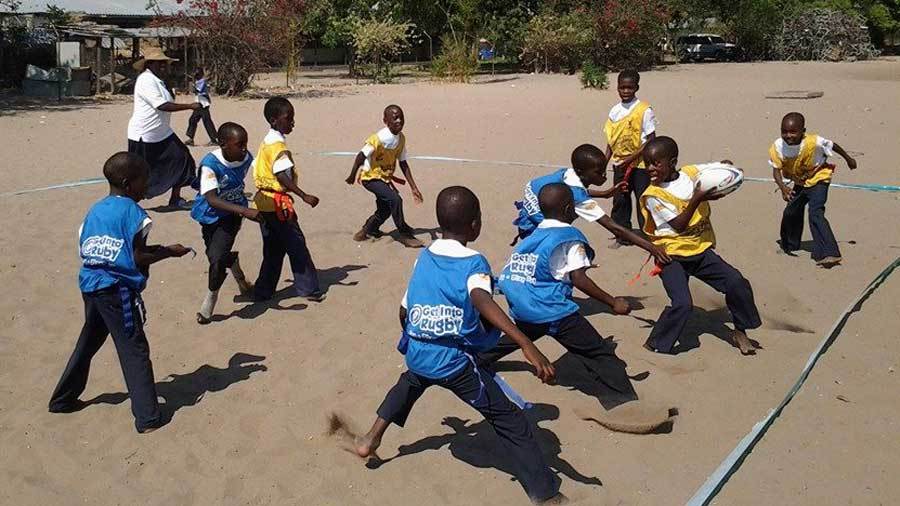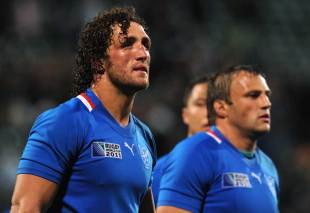|
International Rugby
Finding the next Jacques Burger
Ken Borland
November 19, 2013

Namibian children from Katima Mulilo enjoy some rugby © NRU
Enlarge
Namibian rugby looked on the brink of being reduced to ashes before the last two World Cups but like the proverbial Phoenix, the south-west African nation's burning passion for the sport has seen it prosper and the Welwitshcias are on track to appear again in the IRB's showpiece event in 2015. A number of off-field issues blighted Namibia's Rugby World Cup 2007 build-up and the Namibian Rugby Union (NRU) suffered some financial difficulties before the 2011 tournament. But with both financial and administrative assistance from the IRB, along with the support of some local sponsors, Namibian rugby is once again flourishing. In the forefront of this rejuvenation is Henry Kemp, the former Namibia and Blue Bulls hooker who is now the national team's forwards coach as well as the NRU's development manager. "We are certainly moving forward since the appointment of a new president in Bradley Basson and CEO Sybrand de Beer. They are both good guys who have been able to get the whole system working properly," said Kemp. We will see exactly how far they are moving forward next year when the national team take on hosts Madagascar, Zimbabwe and Kenya in the final round of the African regional qualification for Rugby World Cup 2015. But regardless of how the senior national team is doing, perhaps the best sign of the revival in Namibian rugby is the growing interest in the game among the non-white communities.
The IRB's Get Into Rugby programme has been instrumental in this and, for a country with just 6,800 registered players to have put a rugby ball in the hands of more than 4,000 children in the past year is a massive achievement. "Get Into Rugby is a tremendous programme and the IRB had workshops in South Africa that gave us all training," said Kemp. "It's well set-out and easy to implement. Most schools in Namibia have never seen rugby and it used to be called a 'white man's sport'. "But we've been able to reach nearly 4,500 children through the programme, mostly in rural areas, and they have been taught the basic skills as well as the IRB values. The IRB has been really helpful to us, especially Jean-Luc Barthes, their regional development manager for Africa." Namibia is a vast, arid country, however, and the spread-out nature of the population is a challenge to those trying to popularise the game. "Most of our population is in the northern regions like Ovambo, Okavango and Caprivi so we've targeted those areas specifically. In Katima, I was overwhelmed when 1,200 children came from one school in mid-October. It's about 1,250km away from Windhoek (the capital) and these are deprived areas. But if we want to dramatically change our player numbers - the IRB has set us a goal of 20,000 players - then we must target these regions because that's where half of our talent is," Kemp explains. There's a great hunger for the Get Into Rugby programme in Namibia, with the NRU receiving numerous requests asking why they haven't visited certain areas yet. Rugby is a thoroughly amateur sport in Namibia, however, and a tight budget is obviously a problem but one which has been lessened by a decision to seek out many smaller sponsors rather than one major one.

Jacques Burger is the star of Namibian rugby
© Getty Images
Enlarge
"We get feedback asking why Get Into Rugby hasn't been in their area yet and we will definitely target those places that have requested the programme. It's a sign that we must be doing something right if people are demanding it. "We decided to go for smaller investors, going for 10 sponsors of say N$500,000 (£30,750) rather than trying to find one company to give N$5 million. First National Bank have been fantastic sponsors of Get Into Rugby and someone like Shoprite Checkers, even though they cannot give us money, have provided merchandise in the form of food packages for the kids, which is huge. "We only estimated 2,400 pupils would be involved but the first two schools we visited took us past that mark so I'm in a bit of trouble with the budget. But the government and the public are seeing the progress and that Namibian Rugby is going from strength to strength and the Namibian Broadcasting Corporation are showing regular Get Into Rugby videos. It's a passion for us." Part of that improved image is the return of top-class rugby to the capital, with a Tri-Nations Series that is currently taking place between Namibia, Zimbabwe and Kenya. In the opening game, the hosts beat Zimbabwe 35-26 at Hage Geingob Rugby Stadium. Kemp is fulsome in his praise of what head coach Danie Vermeulen and assistant Walter Don are doing with the national team and the sight of Vermeulen issuing instructions from the side of the field is proof that rugby is really becoming a game for everyone in Namibia. Vermeulen is paralysed from the waist down and wheelchair-bound. If he can be the head coach of the national rugby team, what's to stop a young child currently from a village in the vast Namibian wilderness from becoming a star like Jacques Burger of Saracens? This article originally appeared on IRB.com © ESPN Sports Media Ltd
| |||||||||||||||
Live Sports
Communication error please reload the page.
-
Football
-
Cricket
-
Rugby
-
- Days
- Hrs
- Mins
- Secs
F1 - Abu Dhabi GP
Abu Dhabi Grand Prix December 11-131. Max Verstappen ()
2. Valtteri Bottas (Mercedes)
3. Lewis Hamilton (Mercedes)
4. Alexander Albon ()
5. Lando Norris ()
6. Carlos Sainz Jr ()
-
ESPNOtherLive >>
Golf - Houston Open
Snooker - China Open
Tennis - Miami Open

